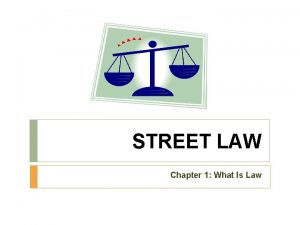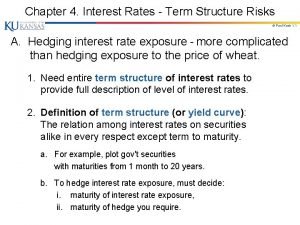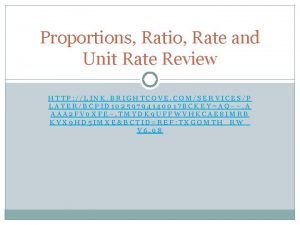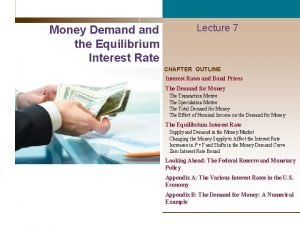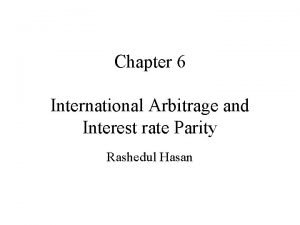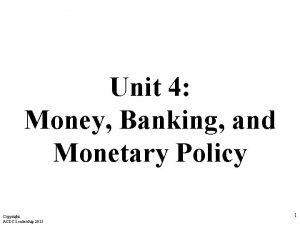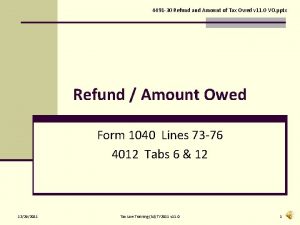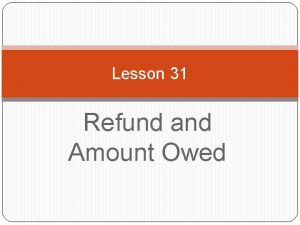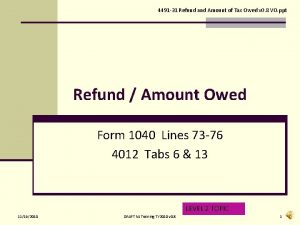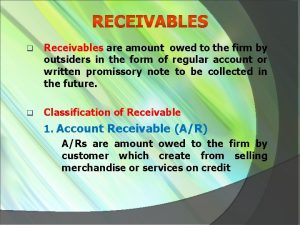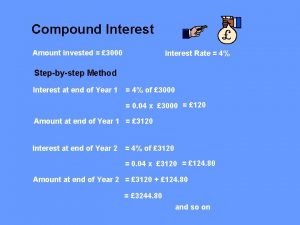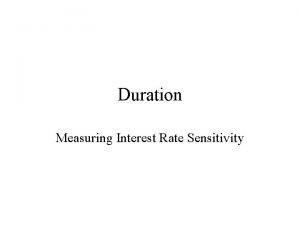Interest and Interest Rate Interest amount owed now














- Slides: 14

Interest and Interest Rate Interest ($) = amount owed now – original amount A) $1000 placed in bank account one year ago is now worth $1025. Interest earned is $25. B) $10, 000 borrowed last year from Sharky’s Easy Money, and you now owe $12, 000. Interest owed is $2000. Interest paid over a specific time period is called an interest rate. Interest rate (%) = interest accrued per time x 100% original amount What is the interest rate in example A and B?

Rate of Return (ROR) – interest earned over a specific time period, expressed as a percentage of the original amount. Rate of return (%) = interest accrued per time x 100% original amount Borrower’s perspective – interest rate paid Investor’s perspective – rate of return (ROR) or return on investment (ROI).

Engineering Economy Other factors that act as interest: • Inflation • Appreciation • Depreciation

Equivalence Economic equivalence – different sums of money at different times can be equal in economic value because of the “time value of money” and interest rates. Example: (assuming 5% interest rate) $1000 today is equivalent to $1050 a year from now. $1000(1. 05) = $1050 $1000 a year from now is equivalent to $X today. $X(1. 05) = $1000 $X = $952. 38 What is the interest rate if an investment of $500 is equivalent to $545 a year from now?

Simple –vs- Compound Interest Simple Interest – interest is calculated using the principal only. interest = (principal)(number of periods)(interest rate) Example: you invest $500 in an insurance policy that pays 8% simple interest. How much is the policy worth in 3 years? Year 0) Year 1) Year 2) Year 3) Principal $500 Interest $40 $40 $120

Simple –vs- Compound Interest – interest is calculated using both the principal and interest earned. interest = (principal + all accrued interest)(interest rate) Example: you invest $500 in an insurance policy that pays 8% compound interest. How much is the policy worth in 3 years? Year 0) Year 1) Year 2) Year 3) Principal $500 $540 $583. 2 Interest $40. 00 $43. 20 $46. 65 $129. 85 Total $540 $583. 2 $629. 85 $500(1. 08)1 $500(1. 08)2 $500(1. 08)3

Power of Compound Interest Historical Perspective – In 1626, Manhattan Island was purchased from an Indian tribe for $24. If that tribe had invested the $24 in an investment paying 8% annually, what would it be worth today? $24(1. 08)(2002 -1626) = $24(1. 08)(376) = $24(3. 69 x 10 E 12) or $88. 56 trillion However, if the tribe invested in an investment that paid simple interest: $24 + $24(. 08)(376) = $745. 92

Symbols and Terminology P – value or amount of money at time 0, also referred to as present worth (PW), present value (PW), net present value (NPV), or discounted cash flow (DCF). F – value or amount of money at some future time, also referred to as future worth (FW) or future value (FV). A – a series of consecutive, equal, end-of-period amount of money, also referred to as annual worth (AW) or equivalent uniform annual worth (EUAW). Does not have to be annual payouts, could be monthly. n – number of periods; years, months, days i – interest rate or rate of return per time period t – time, stated in periods

Symbols and Terminology Example: At the beginning of each year, my wife and I invest $2 K in a college savings plan for our little boy. We did this beginning his first year and plan to do so until his 18 th birthday. We hope to obtain a rate of return of 6% (our current rate is about – 20%). A = $2000 i = 6% or. 06 annually n = 18 F = ? the value of the investment when he begins college

Minimum Attractive Rate of Return (MARR) The Minimum Attractive Rate of Return is a minimum level set by a Corporation when deciding on whether to pursue or not to pursue projects. Expected ROR for a new proposal MARR ROR on “safe” Investment (e. g money market) Is MARR constant from year to year?

Cash Flow Diagrams Cash flow diagrams are a way to graphically represent the inflows and outflows of cash over time. Estimates of cash flows typically follow the end-ofperiod convention (cash flows are assumed to occur simultaneously at the end of an interest period). When several receipts and disbursements occur within an interest period, the new cash flow is depicted. Net cash flow = receipts – disbursements = cash inflows – cash outflows

Cash Flow Diagrams Example: • $70 K Purchase price with 20% down ($14 K) • Monthly expenses (utilities, maintenance, insurance, etc. . ) - $200 • Monthly P&I - $345 • Rental income - $750 $50 K $750 $200 $14 K $545 $50 K

Rule of 72: Estimating Doubling Time and Interest Rate The rule of 72 helps estimate how long is will take for an investment, using compound interest, to double in value. To estimate how many years, n (periods) to double your money: estimated n = 72/i To estimate the interest rate required to double your money in n periods: estimated i = 72/n

Rule of 72: Estimating Doubling Time and Interest Rate Example: If you invested $1000 today in a CD paying 5% annually, how long will it be until the CD is worth $2000? n = 72/5 = 14. 4 years If you wanted the $1000 to double in 10 years, what interest rate must you earn? i = 72/10 = 7. 2%
 Real vs nominal interest rate
Real vs nominal interest rate Regulate public conduct and set out duties owed to society
Regulate public conduct and set out duties owed to society Cap rate interest rate relationship
Cap rate interest rate relationship A salaried worker in a guild
A salaried worker in a guild A salaried worker in the guild system
A salaried worker in the guild system Sociological.imagination
Sociological.imagination Everyone owed loyalty to the
Everyone owed loyalty to the Now i see it now you don't
Now i see it now you don't Plant growth index
Plant growth index Spot forward rate formula
Spot forward rate formula Spot rate and forward rate
Spot rate and forward rate What is the difference between rate and unit rate
What is the difference between rate and unit rate Money demand and interest rate
Money demand and interest rate Locational arbitrage
Locational arbitrage Money supply and interest rate
Money supply and interest rate

